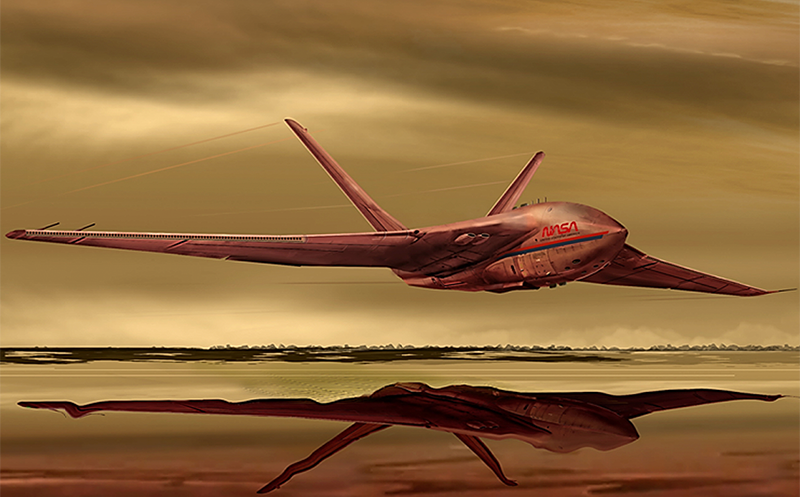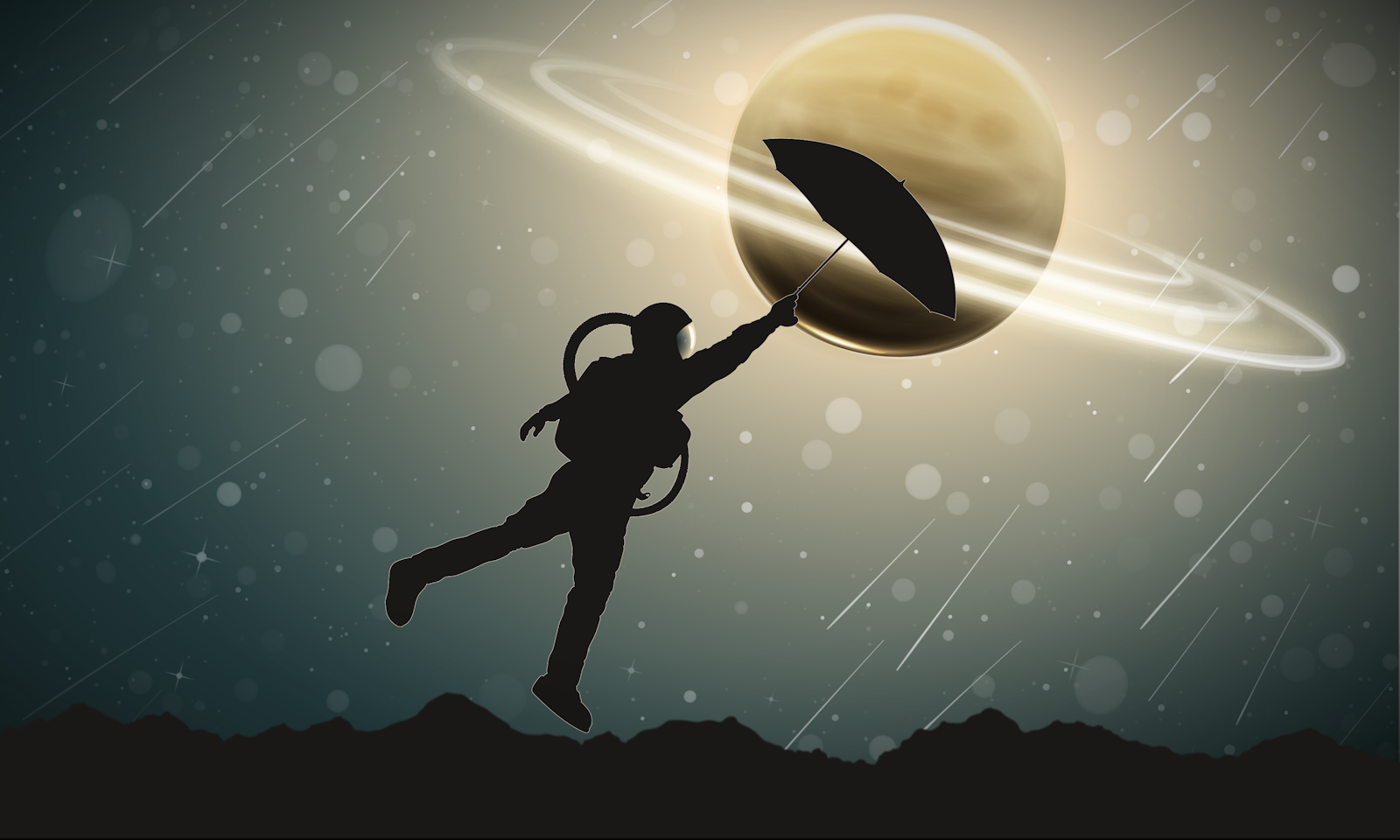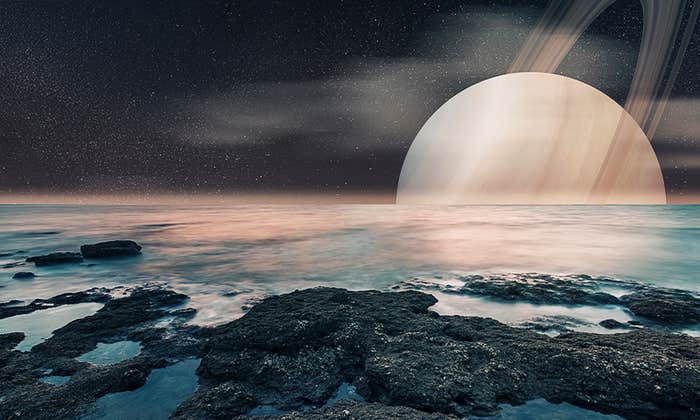In 2034, a small craft will alight on a distant dune in a place called Shangri-la. This craft, called Dragonfly, will have traveled 746 million miles to eventually land on Saturn’s largest—and most alluring—moon, Titan.
Dragonfly is a radical new approach to studying other worlds. Rather than being bound to slowly creep over the surface, as our Mars rovers have been, it is a rotorcraft, capable of flying several miles at a time. It will hop around from place to place to help us better understand this strange land, where the atmosphere is nitrogen, the dunes are made from ice, the seas are liquid methane, and a potentially globe-wide water ocean may be buried deep below the frozen surface.1
The planned Dragonfly mission, set to launch in four years, will include an impressive assortment of remote planetary exploration tools: several cameras that operate at different wavelengths to image the intriguing landscape, a small drill and scoop to collect samples, a mass spectrometer to determine the chemical makeup of those samples, a gamma-ray and neutron spectrometer to study the composition of the surface directly under the craft, and a suite of meteorological and geological sensors to record Titan’s weather patterns and search for evidence of larger-scale activity (such as cryovolcanoes that might spew liquid water instead of lava). This suite of gear will help us get our first true taste of what Titan is really like—and whether it might be holding any important solar system secrets, like whether life could be present beyond our own world.

To date we have only sent one lonely mission to Titan. Launched in 1997, the Cassini spacecraft carried a small payload: the Huygens probe. While Cassini spent nearly two decades in orbit around Saturn, the Huygens probe lasted less than a month between deployment from its parent spacecraft and the end of its operations, a mere hour and a half after touchdown on Titan’s rugged surface.
That mission provided our first on-the-ground view of this alien and unforgettable world. But it created far more questions than answers. What is the exotic chemistry and geology that powers the dynamics of this massive satellite? Where did the methane seas and potential underground water ocean originate? What can this world, rich with organic compounds, teach us about young Earth? And most tantalizing: Is Titan a potential home for life?
Dragonfly will hopefully provide preliminary clues to some of these big questions. But it will, quite literally, barely scratch the surface.
Unlocking more of Titan’s mysteries could help us understand physics, chemistry, and, potentially, biology on distant worlds. To tackle those, we will need to zoom far beyond Dragonfly and dream up the next major missions to Titan. These efforts will take even more expansive, and creative, approaches—to deeply study the science of this strange land, in situ, -290-degree methane rain and all.
Our first priority is to understand the chemistry of this strange world, which could hold the key to uncovering alternative forms of life.
On Titan, things are just … different. High-energy radiation, whether from the sun’s ultraviolet rays or more distantly sourced cosmic rays, interact with a variety of organic compounds held at extremely cold temperatures to create complex molecules called tholins. Tholins are a general catch-all term for a variety of substances that only appear in the distant solar system (they are also dusted around the icy surface of Jupiter’s intriguing moon Europa). To make a tholin, you take a compound rich in carbon, such as methane or ethane or even carbon dioxide, and blast it with ultraviolet radiation at low temperatures. The extra radiation energizes all sorts of peculiar reactions,2 generating a rich variety of new organic compounds.
In the outer worlds these tholins might play a role similar to mud on Earth: A place where life could find all the ingredients it needs to thrive. But it’s tough to bring tholins back to Earth for close study. They easily disassociate in the warmer, inner regions of the solar system, and our oxygen-saturated atmosphere has a tendency to destroy any and all tholins on the spot. So the best place to study these exotic compounds is right at the source, on the surface of Titan.
We need to dip our robotic toes into the methane seas.
While Dragonfly will give us a first glimpse into tholin chemistry, we will need much more substantial operations to fully understand how those tholins are created and what chemical role they play on Titan.3 These insights would help understand their possible prevalence on worlds beyond our solar system, and therefore potential for life in the far-beyond. To do this level of science, we will need to get our hands dirty—to scoop tholins by the bucketful and closely examine their precise chemical makeup—which will require much bigger landers. And to do even more advanced science, we might even want human hands on the ground some day.
All sorts of strange chemistry—and potentially biochemistry—could also be lurking in the methane seas. On Earth, water serves as the solvent for life, giving all of our wonderful biochemistry a substrate for its reactions. Could liquid methane act as substrate for a different kind of life?
The only way to find out is to go looking for it, which means we need to dip our robotic toes into the methane seas themselves. Dragonfly can’t do it, but a proposed mission called TitanAir is a seaplane designed to sail through Titan’s atmosphere, occasionally drifting onto the sea surfaces to take samples.
Titan’s life isn’t going to come out of the depths to wave hello. We have to go find it.
It’s not as simple as flying a plane on Earth, however. TitanAir will face a few challenges as it attempts to aviate around that alien world.
For one, getting all the machinery, electronics, and most importantly the sample collection and examination suite to work in ultra-low temperatures is difficult, to put it mildly. Dragonfly will face similar issues for sure, but TitanAir hopes to not just poke at rocks but sample directly from the liquid methane seas, which will require us to devise new kinds of sensitive equipment. And while Titan has a thick atmosphere like the Earth, it’s much smaller than our own planet, with much lower gravity, so flight takes on a different physics than it does in our own atmosphere. The craft will also have to be ultra-ultra-ultra-clean. Since it’s studying the potential for life and life-like chemistry somewhere else, we have to be absolutely sure that it doesn’t carry any traces of Earth microbes or genetic material with it to contaminate its samples.
And of course there’s the tantalizing possibility of a liquid water ocean below the moon’s frozen surface.4 Depending on the exact composition of Titan, the ocean might be relatively shallow, or it might be rich with ammonia and up to 100 miles thick. Either way, the ocean appears to be geologically active. It receives warmth from the inner core of Titan, and a rich supply of organic compounds from the icy crust above. In other words, it has all the conditions for life as we know it: liquid water, a source of energy, and a source of rich chemicals. The only thing lacking is sunlight, which, as the hydrothermal vents in our own oceans have demonstrated, is not a requirement for life.
But that life isn’t going to come out of the depths to wave hello. We have to go find it. We’ll have to drill through dozens of miles of rock-hard ice, and potentially even send submersibles into that dark ocean. Once we’re there, we may not even know how to find life. Unless it’s big enough to wiggle, we discriminate life against non-life through its various biochemical signatures—the traces that only life can leave behind. But life based on completely different biochemical foundations may not appear to us to be alive. Any evidence we gather will help us better understand the very definition of life, and under what conditions we might find life elsewhere in the universe.
Even if Titan yields no alien biochemistry of its own, long-term, ambitious missions on Titan will give us precious clues not just to worlds beyond, but also to the development of our own planet. We’ve all heard of the “primordial ooze,” the soup rich in organics that somehow gave rise to life on Earth. Titan is a primordial world, with all of the right ingredients in all of the right planes, rich in exotic chemistries that are inaccessible to earthbound laboratories. Titan is a window into Earth’s own past, serenely orbiting Saturn, waiting for future science to help us discover its secrets. ![]()
Paul M. Sutter is a research professor in astrophysics at the Institute for Advanced Computational Science at Stony Brook University and a guest researcher at the Flatiron Institute in New York City. He is the author of Your Place in the Universe: Understanding our Big, Messy Existence.
Lead image: arvitalyaart and Lauritta / Shutterstock
References
1. Wakita, S., et al. Modeling the formation of Selk impact crater on Titan: Implications for Dragonfly. arXiv 2303.11330 (2023).
2. Hörst, S.M. Titan’s atmosphere and climate. arXiv 1702,08611 (2017).
3. Czaplinski, E.C., et al. Experimental characterization of the Pyridine:Acetylene co-crystal and implications for Titan’s surface. arXiv 2303.14847 (2023).
4. Artemieva, A. & Lunine, J. Cratering on Titan: Impact melt, ejecta, and the fate of surface organics. Icarus 164, 471-480 (2003).




























